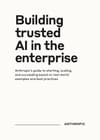🧭 What’s Covered
This guide offers a comprehensive four-stage framework for successful AI adoption in enterprise settings, built around Anthropic’s Claude models and deployments via AWS. It opens with compelling productivity gains—20–50% improvements across functions—and claims from top performers attributing over 10% of earnings to generative AI .
Stage 1: Develop AI Strategy
Focuses on aligning people, process, and technology. Key steps include:
- Executive buy-in
- AI governance boards
- Pilot selection (balanced between impact and feasibility)
- Technical foundation audits, including data architecture, RAG integrations, and structured workflows
Stage 2: Create Business Value
This section dives into identifying effective use cases that are:
- Well-suited to LLM strengths (e.g., summarization, classification)
- Low-risk but high-impact
- Easy to scale across the business
It presents success metrics for different applications (e.g., ticket routing, chatbots, fraud detection) and recommends defining specific, measurable goals aligned with business priorities .
Stage 3: Build for Production
Covers production-readiness steps, such as:
- Prompt engineering (with specific prompt templates)
- Evaluation frameworks
- Optimization using few-shot and Chain of Thought techniques
- Tooling tips like using Anthropic Console for versioning and A/B testing
Stage 4: Deployment
Explains deployment best practices via a lightweight MLOps framework (“LLMOps”), which includes:
- Monitoring output quality and token usage
- Secure handling of data
- Cost management
- Continuous QA
- Progressive rollout, not system-wide replacement
Case studies from Pfizer, Novo Nordisk, DoorDash, Lonely Planet, and LexisNexis provide validation. These examples underscore not just time and cost savings, but also shifts in operational models—like moving from weeks-long workflows to real-time delivery .
💡 Why It Matters
Enterprises are under pressure to show real value from AI beyond prototypes. This guide stands out by breaking down AI adoption into digestible, actionable phases, rooted in production realities—data quality, regulatory compliance, team capability, and prompt iteration. It moves the AI discussion beyond hype, showing what it really takes to shift from “playing with a chatbot” to embedding AI into workflows. It also reinforces the role of trust, governance, and evaluation in scaling AI responsibly.
🚫 What’s Missing
The guide is strong on internal strategy but glosses over external accountability. It doesn’t tackle thorny issues like labor displacement, regulatory risks outside the US, or how Claude’s alignment principles compare to competitors’—issues increasingly relevant in boardrooms. Additionally, while it promotes Claude models, it avoids disclosing evaluation benchmarks against other LLMs. This limits independent assessment of its claims. Finally, the guide implies that LLMOps can be stood up easily—something many smaller orgs would struggle to do without substantial vendor support.
🎯 Best For
Perfect for enterprise leaders, product managers, or IT strategists who need a playbook for operationalizing GenAI at scale. Also useful for legal and compliance teams designing governance structures. Less relevant for policymakers or small startups without deep cloud or DevOps capacity.
📚 Source Details
Title: Building Trusted AI in the Enterprise
Authors: Anthropic
Published: 2024, in partnership with AWS
Focus: Practical playbook for deploying Claude models
Access: Anthropic.com or AWS documentation hubs


